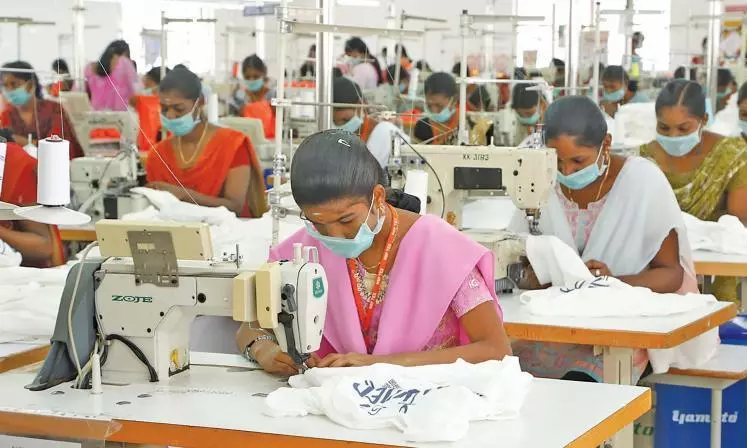
India’s growth outlook faces twin pressures: Tariffs and structural bottlenecks
A new report from CII argues that structural issues and US tariffs could erode India’s manufacturing competitiveness and curb GDP growth

India’s economy delivered a stronger-than-expected 7.8 per cent growth in the first quarter of FY26, but economists warn that the momentum may not hold as external shocks and structural bottlenecks collide.
A new report by the Confederation of Indian Industry (CII), “Policies for a Competitive India”, argues that the country risks losing its manufacturing edge unless it tackles high input costs, fragmented logistics, and regulatory inefficiencies. At the same time, a Kotak Institutional Equities note highlights that India’s growth could be cut by as much as a full percentage point annually if elevated US tariffs remain in place.
Tariff headwinds and fragile buffers
According to Kotak, the recently imposed 50 per cent tariffs on Indian exports to the US, effectively averaging around 33 per cent after exemptions, are likely to weigh on GDP growth from the third quarter of FY26. The sectors most at risk are labour-intensive industries such as textiles, leather, gems and jewellery, and agriculture products, which together employ millions in small and medium enterprises.
The textile hub of Tiruppur is already bracing itself for pain. Tiruppur Exporters’ Association general secretary Thirukkumaran N told The Federal that US tariffs threaten to “wipe out margins entirely,” adding that many small exporters “are running on credit and can’t absorb a 30 to 40 per cent erosion in pricing power.” He warned that if the government does not act quickly with relief, “we could see closures and job losses on a scale that takes years to recover”.
Also Read: Why India must take Brazil’s lead to save Tiruppur from impact of Trump’s tariffs
“If tariffs sustain at current levels, India’s GDP growth could fall by 50 to 100 basis points on an annualised basis,” warned Kotak, adding that the shock could cascade into job losses and weaker consumption.
The CII report makes a similar point from a structural angle, cautioning that India’s competitiveness is eroding because logistics costs remain 14 per cent of GDP, far higher than in competing Asian economies. The industry body says rationalising these costs and reforming energy pricing could provide buffers against external shocks.
Demand drivers show signs of strain
While headline growth remains robust, underlying demand drivers show signs of strain. Private consumption grew at 7 per cent in the June quarter, supported by tax cuts and a strong monsoon, but analysts say urban spending is softening and rural incomes remain vulnerable to commodity price swings. Investment growth also slowed compared with earlier quarters.
Kotak has revised India’s FY26 GDP forecast to 6.5 per cent, up slightly due to the strong first quarter, but flagged that risks are “evenly balanced” going forward.
Also Read: Trump’s tariff hits Indian textiles: Tiruppur exporters under pressure
Other brokerages echo this caution. Nomura said in a recent note that India’s growth “looks resilient on the surface but is overly dependent on fiscal support and global liquidity.” The firm expects growth to moderate in the second half of FY26 as tariffs bite and household leverage rises.
India needs broad set of reforms
Tiruppur Exporters Association's Thirukkumaran pointed out that competitors like Brazil have already begun negotiating carve-outs with Washington, while India has been “slow to respond despite the stakes.” According to him, local firms need both short-term support on working capital and a longer-term trade diversification strategy.
CII’s 300-page competitiveness blueprint argues that India must push through a new wave of reforms to maintain growth at 7-8 per cent sustainably. The CII report calls for a broad set of reforms spanning energy, labour, trade, MSMEs, and infrastructure. It urges the government to move towards transparent, market-linked energy pricing to reduce industrial costs, while also implementing more flexible labour laws that balance ease of hiring with adequate social protection.
Also Read: 50 pc US tariff threatens aromatic oil, handicraft industries
For MSMEs, which are disproportionately hit by both tariffs and high domestic costs, the report recommends targeted support and a lighter compliance burden. On trade, it stresses the need to diversify export markets beyond the US and EU and to pursue reciprocal tariff concessions through regional blocs. Finally, it highlights the importance of cutting logistics costs by better integrating road, rail, and port networks and digitising supply chains.
“The competitiveness challenge is no longer about slogans like Make in India, but about fixing the nuts and bolts of energy, logistics, and regulation,” said a senior CII official at the launch.
Fragility of India’s growth story
The government has already rolled out an income tax cut and GST rate rationalisation to cushion demand, but economists say these are unlikely to offset tariff shocks fully. Fiscal space is also limited, with the Centre targeting a deficit of 4.4 per cent of GDP this year.
Kotak expects policymakers to prioritise targeted MSME relief in the coming quarters. The CII report also urges a shift in fiscal resources towards productivity-enhancing infrastructure rather than blanket subsidies.
Also Read: Indian economy prepares for long haul as Trump tariff strikes home
The divergence between a strong near-term GDP figure and the looming tariff and competitiveness risks highlights the fragility of India’s growth story. For now, capital markets are buoyed by the GDP surprise, but analysts say investors will be watching closely for signs of stress in export-heavy and job-rich sectors.
“India has weathered shocks before, but sustaining momentum will depend on whether reforms move from paper to implementation,” Nomura wrote.

